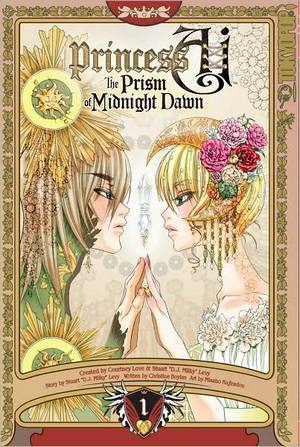- Comics
- Comics Reviews
- Manga
- Comics Reviews
- European Comics
- News
- Comics News
- Press Releases
- Columns
- Spotlight
- Digital Comics
- Webcomics
- Cult Favorite
- Back Issues
- Webcomics
- Movies
- Toys
- Store
- More
- About
By Leroy Douresseaux
December 15, 2008 - 12:49
 |
| Princess Ai The Prism of Midnight Dawn 1 is courtesy of barnesandnoble.com. |
Rating “OT” for “Older Teen: Age 16+”
Princess Ai, the half human/half angel who sings with a mesmerizing voice and is the star of several TOKYOPOP manga, is back in a new graphic novel trilogy. In Princess Ai: -The Prism of Midnight Dawn-, the beguiling young woman returns to Earth on a special mission.
Princess Ai: The Prism of Midnight Dawn, Vol. 1 finds Ai unhappy in Ai-Land. She’s been back a year, existing more or less as a figurehead, propping up the rule of her cousin, Nora. Ai can’t even find the inspiration to compose her music, but a miracle happens. A noble offers the “Prism of Midnight Dawn;” it is a magical gem that has the power to simulcast a new Princess Ai concert to both Ai-Land and the Other Side (Earth).
During Ai’s triumphant return to performing, tragedy strikes, which sends Ai and her bodyguards, the Three Furies, back to the Other Side on an important mission. However, life on Earth isn’t as Ai remembers it. The current popular music sounds bizarre and jarring. There’s a popular new drug, called “tank,” that has put the youth in a daze, and Ai’s human boyfriend, Kent Kawa Scott, is also hooked on it. As Ai investigates, she finds that her former management agency, HTA, has ties to a conspiracy – a conspiracy darker and more far reaching than Ai realizes.
THE LOWDOWN: The return of Misaho Kujiradou, the artist who drew the original Princess Ai trilogy, fails to help Princess Ai: The Prism of Midnight Dawn to pick up where the first series left off, at least in terms of quality. The Prism of Midnight Dawn isn’t bad, and by no means is Kujiradou’s art poor. It’s just that this new series comes across as but a shadow of the first.
To start with, D.J. Milky (the pen/performing name of TOKYOPOP CEO, Stuart Levy), who co-created Princess Ai with rock musician Courtney Love and who scripted the first series, only provides the story for The Prism of Midnight Dawn. Christine Boylan (who has written for both DC Comics and TOKYOPOP) is the new scripter, and her work doesn’t quite capture the rhythm, style, or even flavor of the first series. Once again, it’s not bad work; it’s just not as good as the original. Boylan does give the story some edge in the last third of this book, so the upcoming chapters have the potential to be thrilling.
Kujiradou’s art, which was so stylish and absolutely beautiful in the first Princess Ai, is now more practical. The composition focuses on storytelling, which is fine, except that in the first series, the beauty of the art contributed to the mood of the story and also managed to be eye candy at the same time. What was exceptionally pretty is now merely stylishly functional.
POSSIBLE AUDIENCE: Fans of Princess Ai.
B